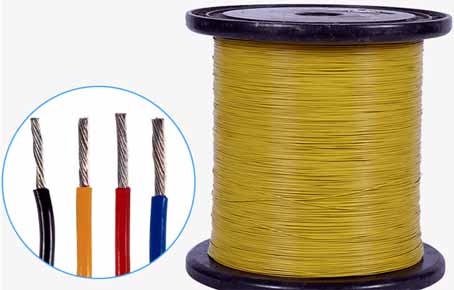Manufacturing and testing of fluorinated wires and cables

purpose: It is to determine whether the ETFE electrical insulation material of the fluorinated wire is thermally decomposed, whether there is a compound that corrodes the metal connector.
Sample: ETFE (ethylene/tetrafluoroethylene blend) particles and insulating layer.
condition
Test equipment: TGA combined with Nicoeli Nexus FTIR
Crucible: 70 μl alumina crucible without lid
Sample preparation: The pellets (33.610 mg) were not processed. The wire is removed from the cable (29.038 mg).
TGA test: heating from 25°C to 600°C at a rate of 20K/min.
Atmosphere: Nitrogen, 50ml/min
The decomposition of ETFE-based materials presents two weightless steps. The particles decomposed almost completely, leaving only 3.6% residue. The residual weight of the insulating material is 21.2%, which indicates that it contains fillers. The peak of the DTG curve of the first step of the particle sample at 270°C is very obvious. The first-order derivative curves of both samples show a smaller decomposition process at 420°C.
The composition and decomposition behavior of the two samples are significantly different. The first weight loss of the insulating material (DTG peak at 270°C) shows the presence of nitrile groups (2300-2200 cm-1). The stronger absorption band at 1025 cm-1 is due to the existence of the C-F haloalkane bond. However, the spectra corresponding to the first weight loss peak of the particle sample show the absorption bands of alkyl aldehydes at 1450 cm-1 and 1750 cm-1.
The IR spectra recorded during the second weight loss step (DTG peak at 510°C) indicated the presence of fluorinated alkanes (1500-1000 cm-1). The relative intensity of the alkane fluoride absorption band at 1025 cm-1 of the insulating material spectrum is still relatively strong. It is worth noting that hydrogen fluoride (4000-3500 cm-1) generated during the processing of insulating materials can be observed, but this characteristic spectrum is not clear in the spectrum of the particle sample.
The main functional groups that escape gas from particles and processed insulating materials are identified. The absorption band mentioned in the previous discussion shows that the processing of the raw material affects the formation of the corrosive compound hydrogen fluoride. The results show that the insulating material studied is incompatible with the metal connector.





